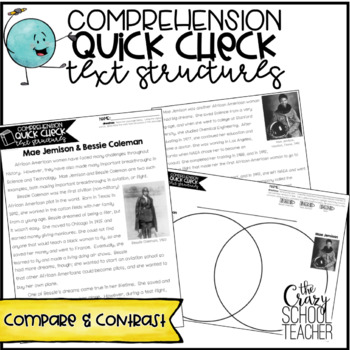Black History Month Reading Passages for Compare & Contrast Text Structure
- PDF
What educators are saying
Description
For Black History Month or any time of the year - Help your students learn to easily identify the Compare & Contrast text structure with these three reading passages and questions. Easily integrate reading and social studies with these high interest, nonfiction reading comprehension passages and questions about African American history. These reading passages focus on the nonfiction text structure of Compare and Contrast. Your 3rd, 4th and 5th grade students will be engaged in learning important reading skills while also meeting social studies standards. Each well-developed reading passage includes questions about informational nonfiction text structures, as well as a graphic organizer.
Black History Month Nonfiction Reading Passages for the Compare & Contrast Text Structure includes passages on:
- Mae Jemison & Bessie Coleman
- Fredrick Douglass & Sojourner Truth
- Massachusetts 54th Regiment & Tuskegee Airmen
These reading comprehension passages are perfect for a whole class skills practice, as part of a social studies lesson, small group reading instruction, a Black History Month unit, an independent literacy center, and more.
Common Core State Standards addressed in this resource:
CCSS.ELA-Literacy.RI3.1 Ask and answer questions to demonstrate understanding of a text, referring explicitly to the text as the basis for the answers.
CCSS.ELA-Literacy.RI3.3 Describe the relationship between a series of historical events, scientific ideas or concepts, or steps in technical procedures in a text, using language that pertains to time, sequence, and cause/effect.
CCSS.ELA-Literacy.RI3.7 Use information gained from illustrations (e.g., maps, photographs) and the words in a text to demonstrate understanding of the text (e.g., where, when, why, and how key events occur).
CCSS.ELA-Literacy.RI3.8 Describe the logical connection between particular sentences and paragraphs in a text (e.g., comparison, cause/effect, first/second/third in a sequence).
CCSS.ELA-Literacy.RI3.9 Compare and contrast the most important points and key details presented in two texts on the same topic.
CCSS.ELA-Literacy.RI3.10 By the end of the year, read and comprehend informational texts, including history/social studies, science, and technical texts, at the high end of the grades 2-3 text complexity band independently and proficiently.
CCSS.ELA-Literacy.RI4.1Refer to details and examples in a text when explaining what the text says explicitly and when drawing inferences from the text.
CCSS.ELA-Literacy.RI4.3 Explain events, procedures, ideas, or concepts in a historical, scientific, or technical text, including what happened and why, based on specific information in the text.
CCSS.ELA-Literacy.RI4.5 Describe the overall structure (e.g., chronology, comparison, cause/effect, problem/solution) of events, ideas, concepts, or information in a text or part of a text.
CCSS.ELA-Literacy.RI4.10 By the end of year, read and comprehend informational texts, including history/social studies, science, and technical texts, in the grades 4-5 text complexity band proficiently, with scaffolding as needed at the high end of the range.
CCSS.ELA-Literacy.RI5.5 Compare and contrast the overall structure (e.g., chronology, comparison, cause/effect, problem/solution) of events, ideas, concepts, or information in two or more texts.
CCSS.ELA-Literacy.RI5.10 By the end of the year, read and comprehend informational texts, including history/social studies, science, and technical texts, at the high end of the grades 4-5 text complexity band independently and proficiently.
CCSS.ELA-Literacy.RI6.5 Analyze how a particular sentence, paragraph, chapter, or section fits into the overall structure of a text and contributes to the development of the ideas.
CCSS.ELA-Literacy.RI6.10 By the end of the year, read and comprehend literary nonfiction in the grades 6-8 text complexity band proficiently, with scaffolding as needed at the high end of the range.
CCSS.ELA-Literacy.RH.6-8.5 Describe how a text presents information (e.g., sequentially, comparatively, causally).


